Working in the game industry often leads to some interesting career trajectories. Case in point: Our current interviewee.
I first saw West-Maison’s art on Twitter and was immediately impressed.. After following him for some time, I became very interested in his career and work. West-Maison’s time in gaming fandom and development took him down interesting paths: After working on a PC game at a small studio, he found himself helping in the creation of some of ADK’s finest games, then moving into development of portable, small-scale LCD games before helping to define the look of Konami’s early Bemani content and a popular toyline. Nowadays, he creates high-quality cosplay props for numerous clients.
Throughout everything, his love of art and gaming has remained strong. I approached him for an interview about his work, and he was eager to talk. Read on for a trip through a very interesting career!
Please introduce yourself to our readers!
Nice to meet you! This is West Maison.
During the 1980s, I became obsessed with video games and other media, and in the 90’s I began working at game companies with a specialty in graphics work.
Since the late 2000s, I’ve retired from the industry workforce but have kept up hobbies for things that I enjoy doing: drawing illustrations, creating various goods and cosplay props.
I feel that it’ll be difficult to tell everything that I want to in writing, so to combat that I’ve prepared a “resume” of my work that anyone can understand at a glance. Please understand that I am giving my full *subjective* viewpoints when telling these stories, which is separate from any company responsibilities I had during my time working in the game industry.
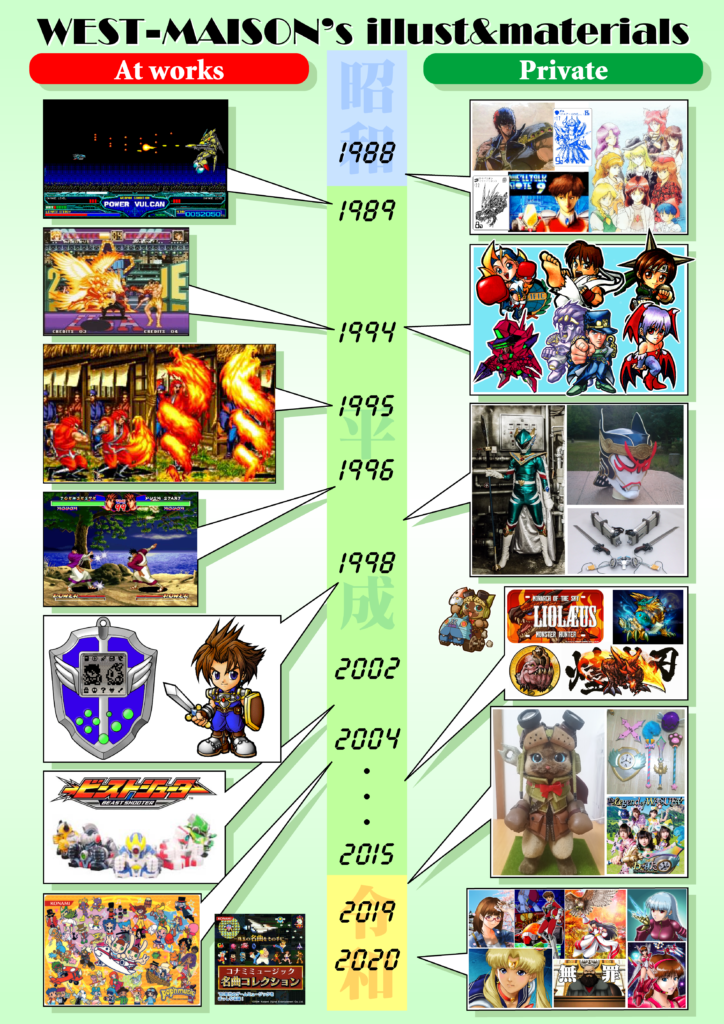
Can you tell us a little bit about your background, and what got you into video games? What’s the first game you got really obsessed with?
Before I became obsessed with video games, two factors that got me going in that direction were the LSI pocket games, as well as the Nintendo Game & Watch. The LSI games came at a time where “Invader Games” were prohibited in school, so I never had the chance to get into Space Invaders.
Because of that restriction or maybe my reaction to it, I became utterly obsessed with Bandai’s “Missile Invader”, which I purchased for New Years’ at the time. I was also mesmerized by the portable version of Game & Watch. Because I didn’t own a watch during that time period, I remember being totally ‘culture shocked’ by the in-game combination of games and watches.
What were the arcades like where you lived? What sort of games were popular? Do you have any anecdotes about the arcade?
I was born and raised in Northern Japan, in a rural area of Aomori Prefecture. My exposure to game centers was generally limited to 4 different types during the 80’s: game cafes, privately managed mid-sized game centers, Department store game corners, and lastly Game centers directly managed by game companies.
Among game cafes, (Space) Invader Cafes were super popular. (Editor’s note: it was quite common to see arcade games in cafes in the late 70s and early 80s, particularly around the Space Invaders boom. However, many cafes got rid of their game machines in the wake of laws passed during a mid-80s moral panic over arcade games.) Both game cafes and privately owned mid-sized game centers were often labeled with a bad reputation, due to how dark the insides of the game rooms could be. The latter of the two types — department store game corners and company-managed game centers — have strong roots left behind even now in Japan. There has been a drastic reduction in the number of game centers since then, and I don’t believe this was limited to just my hometown.
What were the popular games? During the 80’s, Sega games were particularly popular in game centers. Outrun and Afterburner for example. As for incidents that occurred at game centers, extortion was definitely a thing that happened. I never experienced it myself, but it did happen to a regular at the local arcade once. Obviously that person (the extorter) never returned once he got caught.
You’ve shared some of the illustrations you did for communication notebooks at a Taito Arcade called We’ll Talk. Can you tell us a little about that arcade? What was the community like there? Is the arcade still around?
The Note illustrations I posted on Twitter are from the Toyama Game center’s Communication Notes, during the time I moved to that prefecture. The game center from my hometown (Play City Carrot: Namco-managed) also presented them in a similar way. However at the time there were no leftover materials to show so nothing could be exhibited to the public. There’s a possibility that some things might be left over at my parents’ home, so if they somehow are dug up, I’d announce it on Twitter.
Moving along, questions from We’ll Talk Taito! As you know, this is Taito’s directly managed store. Until the 2000’s, this chain was nationwide. As of right now, it has become part of Taito Station, and most of the stores are now closed.The store where I was a regular at, We’ll Talk Taito at the Toyama Chuu-Ou Doori store, closed at the beginning of 1990. While I don’t have photos of the store, by pure coincidence there is one picture that was taken nearby that I have. In this photograph, the store is visible deep on the left side. By the way, the one doing the jump-kick in the picture is really me, haha!
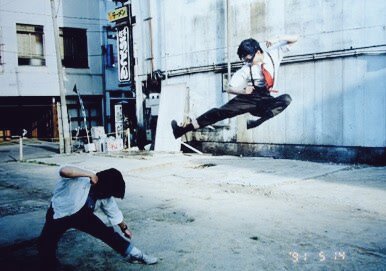
The atmosphere of the place was great, and the main worker was a middle-aged lady who would run the store by herself. Not only was she a frequent companion for conversation, but it was from her that I received the idea for the Note. It was from this place that I made friends who also loved games.
Community notebooks were popular in Japanese arcades, but that sort of thing was almost completely nonexistent in the West. Can you describe what these notebooks were and how they were used for the benefit of players and arcades?
It looks like Gamecenter Communication Notes were a characteristic unique to Japan after all. Customers would be able to freely jot things down wherever these Communication Notes were placed, which was usually inside the store installed on the countertop . While some of these notes were prepared by the store, there were those that were also created by the store regulars.
While you could simply write about the appeal of going to the gamecenter by leaving notes such as, “With various purposes, I’m here visiting!”, more importantly these Communication Notes served as a pre-internet-era information source, message board, and a way for regulars to communicate together.
A lot of people feel that the Japanese have a difficult time speaking to others when you first meet them face to face. In a way, these Communication Notes may have first come to be as a method for solving this issue.
While almost all Game centers left out canvas boards, I was especially good at drawing. Through art I conveyed the appeal of things I liked, and drew them in the Notes. I ended up doing a colored drawing that became the cover page of the Note.
What were some of your favorite arcade games?
My Top 3 Best Arcade Games:
The Tower of Druaga
Made during the dawn of the RPG era, Tower of Druaga was a Japanese action RPG. The very first impression I had of this game was that it was extremely simple, but soon I became completely engrossed in it. The character designs by Shinozaki Yuichiro (Shino Shino) are revered even now. I started drawing Super Deformed characters (Chibi) due to this game’s influence. I drew a picture in the 80’s with a ball-tipped pen, and more recently colored it with CG.
(I STILL can’t beat this game with just one coin…^^;)
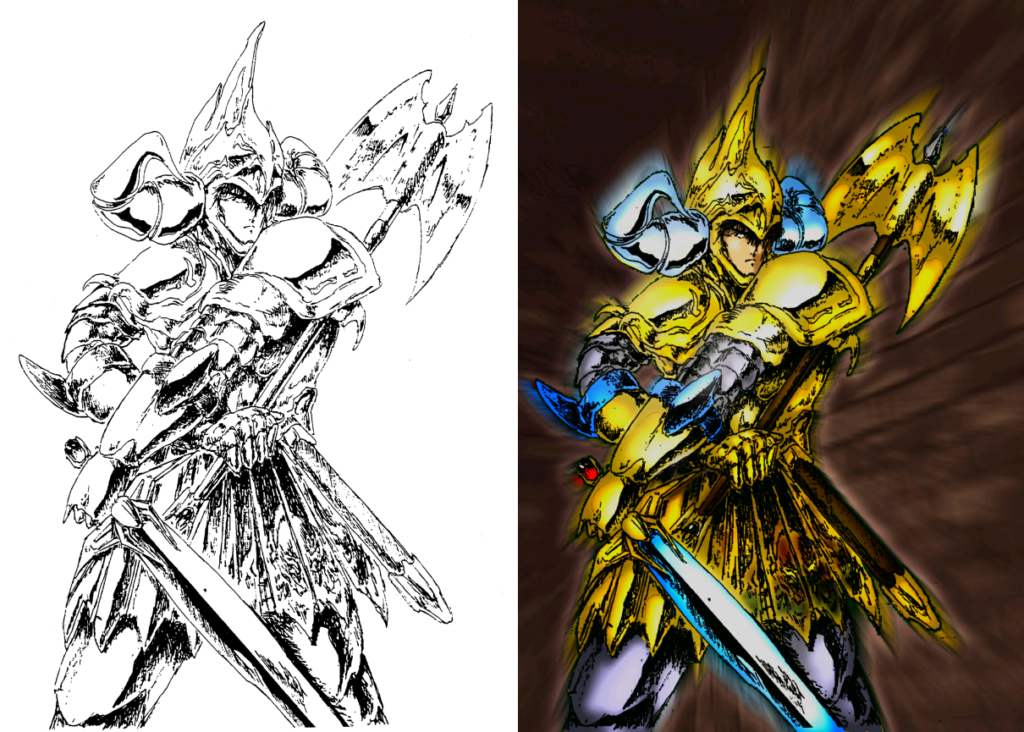
2. Street Fighter II
The game that started the fighting game boom worldwide, and although it is known as a monumental work, I’ve both privately and publicly taken various influences from it.
This was also the catalyst for me to begin working in fighting game production.
Before getting pummeled by Ken Masters’ flame Shoryuken, there are stories of me getting blown up in World Heroes (lol). (On that note, I was the one who later added the fire effects to Fuuma Kotaro’s “Enryuuha” in World Heroes.)
Also at the time, with my wife who played Chun-Li, my Guile didn’t stand a chance and I lost 50 matches out of 50 fights. Even now this remains a good memory.
This POP drawing was done for Game centers in the Street Fighter II dash era.
3. Night Striker
Although it’s outside of what you could describe with the usual game genres, this game definitely left a strong impression. Because it utilized the Stage branching system you’d see in games like Darius and had multiple endings, I played this game countless times. I loved both the BGM and game worldview.
The illustration of Night Striker in the gallery above was for the aforementioned We’ll Talk Taito Communication Note!
What were Japanese game magazines at the time like? Did you ever submit your artwork to magazines like Gamest? Were there any other noteworthy publications (“official” or doujin) for arcade games?
During the 80’s there were three main game magazines for arcade game information: My Computer Basic Magazine, Comptic, and Beep. However, because these weren’t arcade specialty magazines, information was limited to smaller “corner” sections.
GAMEST, the magazine that you know, popped up at the end of the 80’s and was the first Arcade Game specialty magazine. Contrary to what you might expect, I’ve actually never had an illustration featured in a game magazine. I’ve never really been interested in being featured. Make no mistake though, I love drawing!
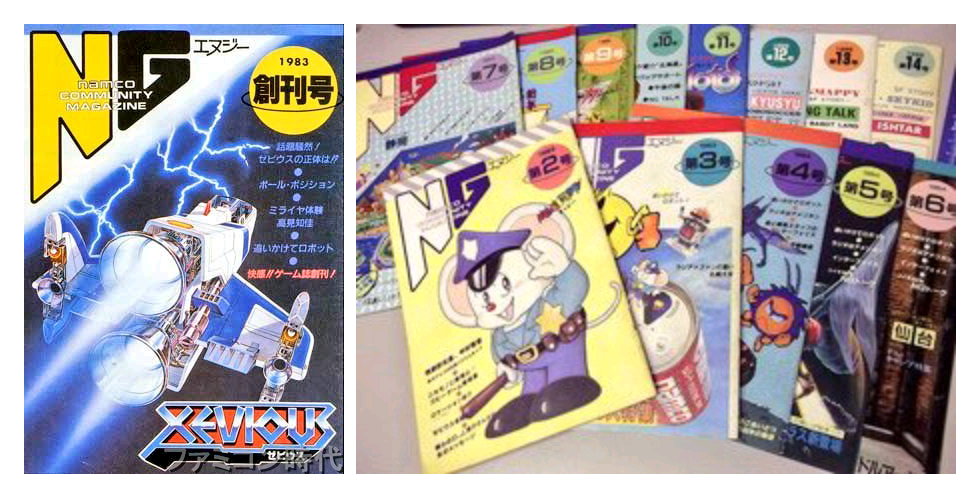
Although it’s not a game magazine per se, Namco’s PR magazine “NG” was famous. There was a Namco-managed store in my hometown, so it was easy for me to pick up issues.
The content was not limited to only game info, but also featured a lot of interesting articles such as dot picture courses and location information, resulting in each issue handling tons of interesting content. Personally, I liked the manga series of Fuji Hiroshi-Sensei, famous for the character design of “Valkyrie no Densetsu”, and I also liked the time a modeling course was featured.
Did you ever do any doujin work before you went professional?
I was never involved with any Doujin circle at the time. I did, however, illustrations of various types: Shikishi, flags, placards, and other various drawings.
There was also a card game that I worked on with regulars from Toyama’s We’ll Talk Taito to make, 100 character cards of which were decided by using the Communication Note as a poll and using the results.

The game system and design was created by me. The card game was titled “Dengen Senshi” (Electric Illusion Warriors) and received a limited release. There is no leftover data, manuscripts, or physical materials in existence, so all I have are materials that I posted on Twitter.
After that, I mainly tabled at Comiket, drawing SD fighting game characters on laminated badges. First, we’d laminate the illustration and tear off into the right size, then attach a safety pin. Because they were so simple to make, we ended up making quite a large volume of them.
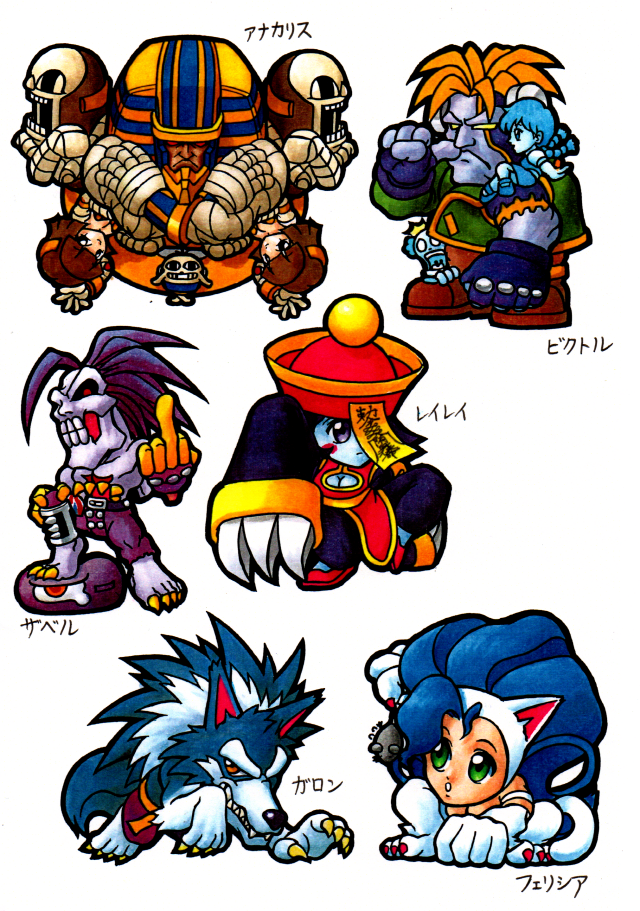
Besides arcade games, did you enjoy any particular console/PC games?
As far as consumer household games, I was obsessed with the Famicom (NES), but even more considerably so with the Sega Mark III (Master system). That all started with the release of the portable version of Fantasy Zone. The only fault was that the controller was definitely not designed with action games in mind, so I used the MSX controller instead. There were various other games I played on various consoles such as the Master System, Mega Drive, Super Famicom and Game Boy.
I didn’t have a PC at the time so I didn’t get to experience much of the PC game world. If I was forced to name some, I definitely remember playing Metal Gear 2 and Ys all the way til the end of the night at a friend’s house.
I didn’t have a PC, but I did have a Pocket Computer (Poke-Con). I’ve also published and posted programs for the Pocket Computer before. My game program is actually featured on this issue’s “My Computer Basic” magazine’s cover from a little earlier.
How did you get into the game industry?
What really started off my entrance into the gaming industry was actually an ad for part-time help posted on the wall of a Gamecenter. That was for the Toyama software development team “Fuuga System”.
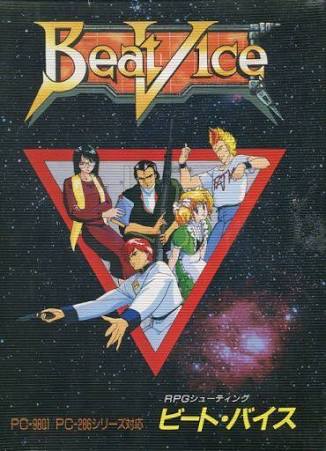
Can you tell us a bit about Beat Vice, your first professional game project? What did you do for that title?
I became involved in the “Beat Vice” project, a simulation-shooting game for PC-9801, which was developed by Fuuga System. Due to it being a small company, I have a memory of there only being one or two graphic designers on the team (including me on part-time contract, that brought the Graphic Designer count up to 2 people).
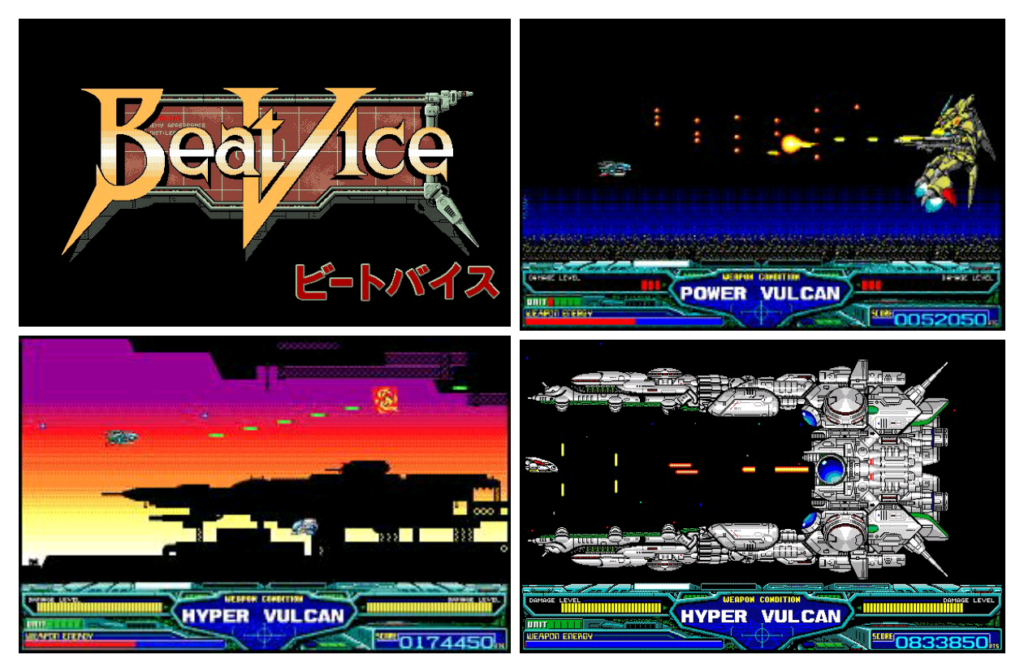
Beat Vice was a game that was split into a simulation section and shooting section. I primarily worked on creating the shooting graphic design for the game. There are numerous aircraft that you can buy with the in-game purchase system. We created more than half of those designs (as well as the background design, UI, and enemy characters). One accomplishment of note was that the huge Boss-Class enemy character was given its distinct rattling movements with our in-house animation tool. I was the one who coined the game’s title too.
I thought to myself, “Is it alright to contribute this much as a part-time job?” LOL
What brought you to ADK specifically?
This position was also thanks to a GAMEST “For-Hire” ad that I responded to. I thought it truly would be a waste to have the skill of a graphic designer but not be able to make a living using said skills.
Right when I submitted my application was when the name of the company changed from Alpha Denshi (Corporation) to ADK. In the first job screening I applied for work. During the second job screening interview, I was told, “We’ll let you know at a later date if we are hiring”, so right at the end I spoke up, “Actually I’ve done this kind of work” and presented Beat Vice’s production materials. After that, they said, “So, let’s continue our onboarding conversation.” And that’s about all I can say, haha.
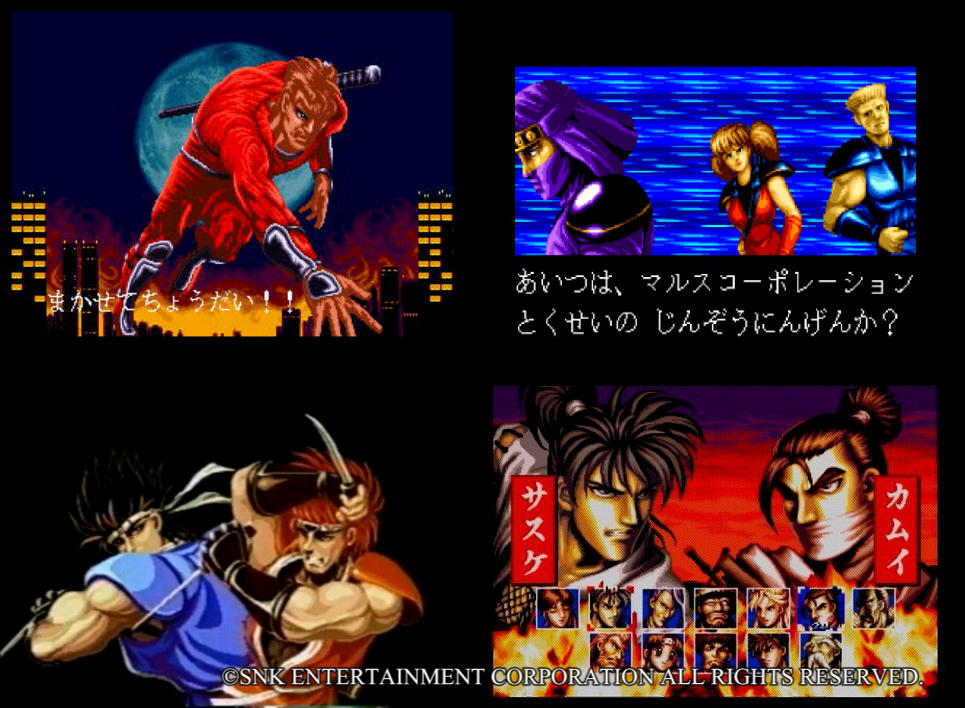
What was ADK’s relationship with SNK like?
During the Alpha Denshi Corp. period, various manufacturers collaborated, one notable example being SNK’s deep involvement in the development of NEOGEO and forming an especially close relationship. Because of this, I had mistaken ADK as a subsidiary company of SNK. I don’t have the details, but I heard the relationship wasn’t so great between them in the later years.
ADK is somewhat notorious among fans for having ninja characters in all of its games. Was there a particular reason for this?
Arcade games are also available abroad, so in order to market such international games, it was a necessity to create games that would be desired overseas. More so than Japan’s 2D anime-style pictures, the graphics often featured richer, more realistic imagery,
I don’t know where I read this comment but it seems like abroad, ninjas are like superheroes. Well not really a hero but more like an antihero. They have the image of a superhuman as they possess strength, can scale buildings and travel at fast speeds without making a sound. And apparently they only eat Tofu?! (lol) Because their image is so strong, there is no way that we could not use them, so ADK seems to have a frequent tendency to feature ninjas.

What was the first title you worked on at ADK?
After completing ADK’s in-house training prerequisite, the first project I was involved in was World Heroes 2 JET.
Aside from myself there were several other new hires at the time. The new members were all sent to work on GANGAN (Aggressors of Dark Kombat), with myself being the sole member that was sent to work on 2 JET. I was assigned the task of giving existing characters additional graphic effects. I was behind the effects for Janne’s Firebird. After completing that work I joined back in with the development of GANGAN.
What was development for the Neo Geo like? What sort of computers and software/hardware did you use to draw?
We used our in-house graphic production tool on the X68000. Feel-wise, it functioned in pretty much the same way that the Fuuga System dev tools did. I remember both tools being extremely user friendly.
Can you tell us about some of the work you did on the World Heroes titles? Did you help develop any character concepts? (Also, which official World Heroes art pieces did you draw?)
There were already designers that were tasked with doing original character designs for both World Heroes and other games besides it. Personally I have never worked on the character design of any NEO GEO developed title.
However, I found worth in exploring already existing characters and bringing out their appeal by adding additional effects and techniques. One particular one I enjoyed was giving Hanzou a new win pose! On social media, I saw a story about someone who was overjoyed whenever they saw Rasputin’s Secret Garden and Mudman’s Heaven’s Blows in World Heroes Perfect, and were hype to see an in-game gallery, so I was happy that I put in that extra work.
It was typical for the public relations team to handle the production of official illustrations at the time. 2 JET appointed the mangaka/illustrator Ruria 046 for that purpose.I produced several illustrations to be used for a GAMEST World Heroes 2 article, such as for the 2P color variation section that included Hanzou, Dragon, Muscle Power, Brocken, and Captain Kidd. I also completed ‘Other Cut’ illustrations as well. Another contribution I drew was the package illustration for Scitron’s CD and Video releases. Finally, both the ADK Official Doujinshi and the Sega Saturn version of World Heroes Perfect got a 4-panel manga that I drew a part of.
Do you have any fun stories about World Heroes 2’s development?
Because my first time being a full project team member was with World Heroes 2 JET, my involvement with World Heroes 2, the previous installment, was limited to just illustrations. Speaking of 2 JET, I was also tasked with doing the voice acting for 2 JET’s Ryofu. For Ryofu, it was just shouting for the voice work, but finally in World Heroes Perfect, he finally received actual lines. 「Hae ni nare (become ash)!」「Guhahaha Ukete Miro (Try taking this)!」Sadly though, it was only those two lines. (Editor’s note: West Maison mentioned on Twitter that Muscle Power was actually voiced by his boss at ADK!)
In addition to doing Janne’s Firebird effects, in Perfect I was assigned to work on all effect graphics for all the characters. From way back, I always enjoyed drawing animals, so I remember especially enjoying working on Captain Kidd’s Shark Knuckle as well as Erick’s Whale Bringer.
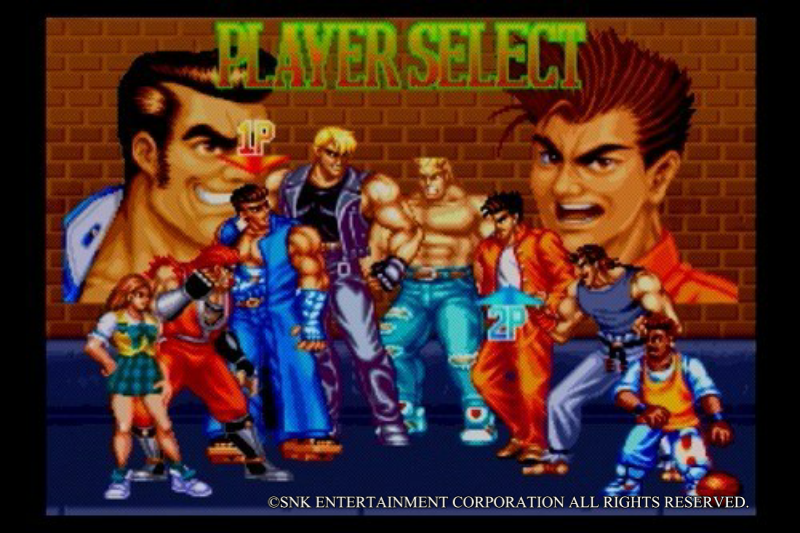
Can you tell us a about your work on Gangan? The game has a reputation for being very strange and silly — what was development like?
This was most definitely a weird title with a weird perspective. The main producer at the time was also a bit eccentric. I can’t say too much about that though.
I contributed to the game as a sub-designer of one character, “Kidokoro Gou”. His appearance is typical of what is known as a “Bankara” (Generally, a person with rough speech and appearance, typically wearing a cloak, geta and towel around the waist, to act as a counter-culture towards the Haikara movement, referring to those who sported western clothing and lifestyle), wearing Geta footwear and sporting a Pompadour. His school uniform and bandages complete his characterization. The pencil picture featured in this Communication Note is an informal depiction of Gou. You may already know this but the overseas title of GANGAN, “Aggressors of Dark Kombat”, forms the same acronym as ADK.
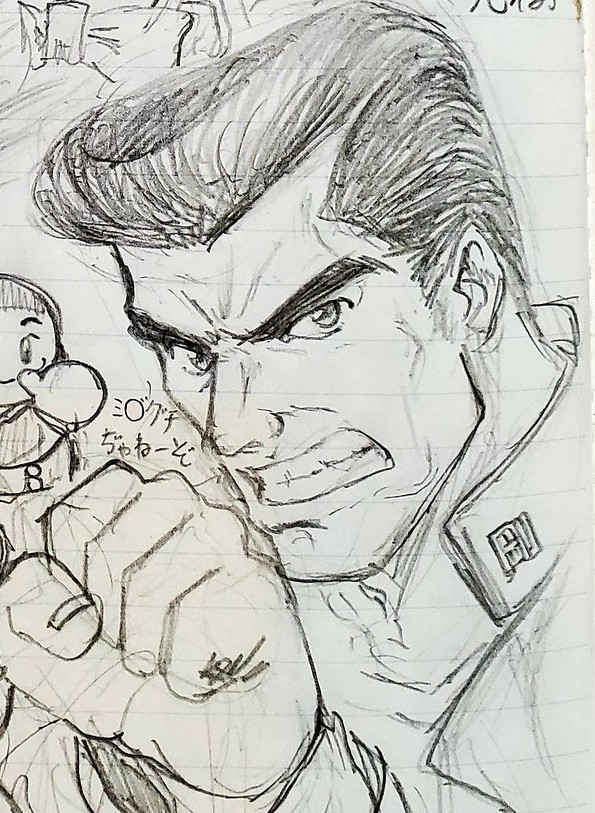
How did the idea for Ninja Master’s come about? What sort of work did you do on that title?
I assisted with the planning of ADK’s well known Ninja character fighting game. While World Heroes was the main fighting game, I wanted to release a sword-fighting game in the vein of Samurai Spirits/Shodown. However, not every character was a ninja; the game included characters with various styles and appeal. I worked on the Demon master, Houoh.
There’s a “Team Jigocky” image in the end credits of Ninja Master’s — what exactly WAS Team Jigocky?
Oh, this?
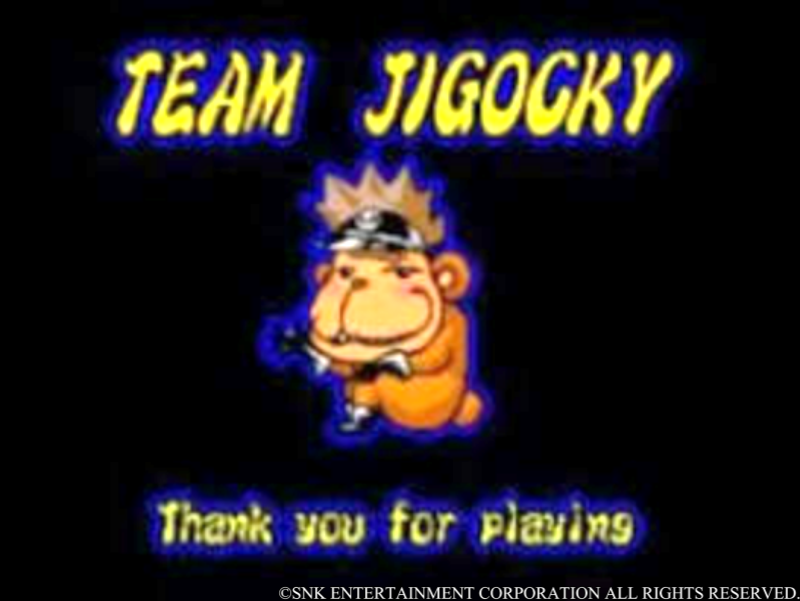
This was the name for the Ninja Masters project team at the time. SNK often had the project team names featured in the end credits of a game, so most likely that’s what this was. By the way, “Jigocky” could be interpreted as a contraction of “Monkey from Hell”. Maybe that could also be called “Shi-gocky” too? Who knows.
By the time Ninja Master’s was released, the Neo-Geo hardware was starting to show its age. Did ADK consider any projects for other platforms, like the Hyper Neo Geo 64?
I wanted to look into the Hyper Neo Geo 64, but it seems that either due to financing or development power issues, there was difficulty moving forward with the idea. From around that point onwards, ADK may no longer have had a good relationship with SNK. However, I can’t verify any of this as fact, as this was just a gut feeling I experienced at the time.
Did you work on any other games or projects at ADK?
I was involved in the development of a unique game, the “competitive-shooting game” genre title Twinkle Star Sprites.
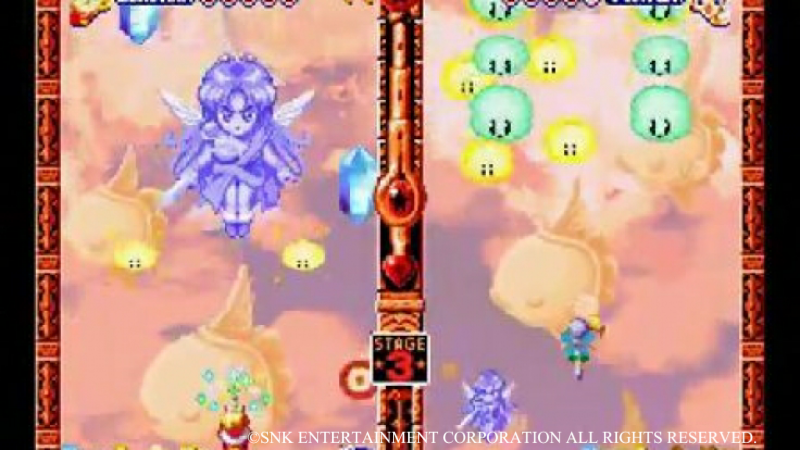
While I was simply in charge of part of the graphic design, I started off consulting on the game system development, and from these talks, unique systems such as the “RenBaku (Consecutive Explosion)” were born.
Outside of my work with NEO GEO, I worked on a LCD portable game system for the President of Production at ADK. This was during an unprecedented Tamagotchi boom, and it looked like they were trying to pursue a low budget hit. Because I was from the Game & Watch generation, I immensely enjoyed being part of the planning team for a self-contained portable game system.
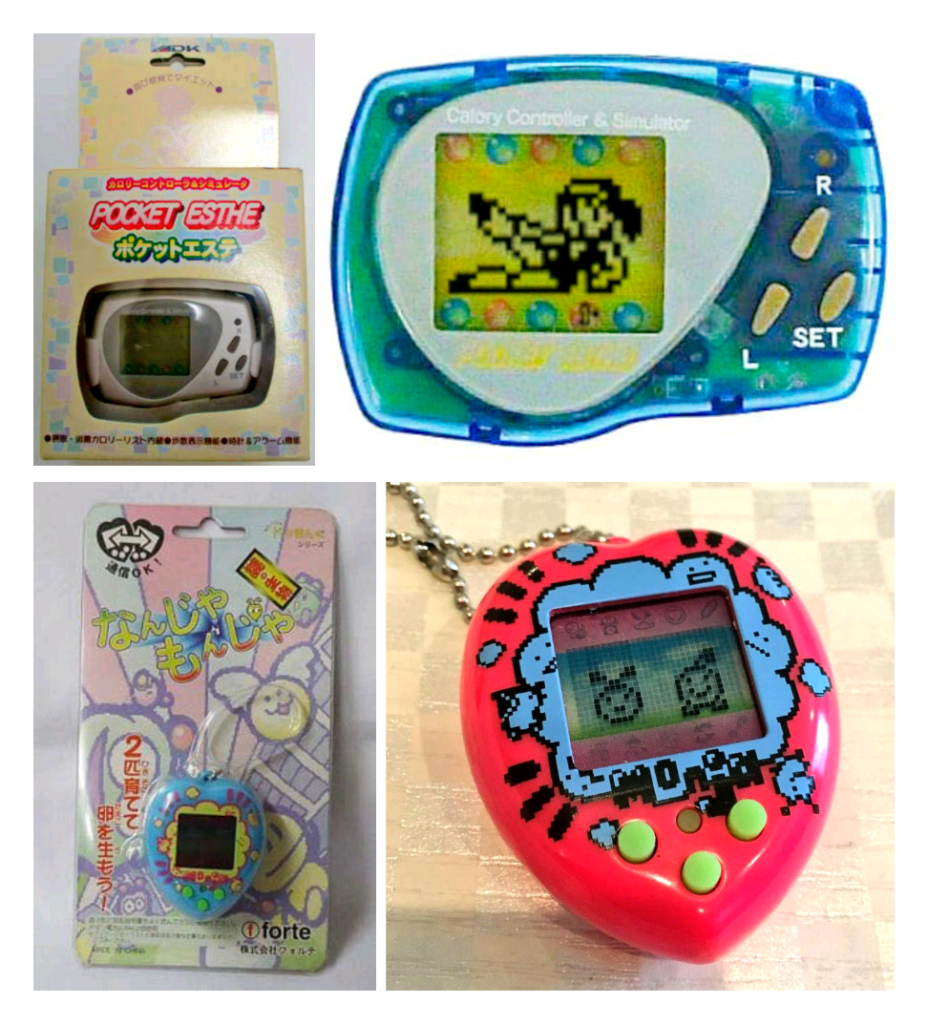
I became engaged in the development of countless portable games such as “Pocket Este”, which was a calorie calculator. I also helped develop “New Species Discovered! Nanjamonja,” let you crossbreed 2 different types of virtual pets.
Can you tell us a bit more about your work on Twinkle Star Sprites?
It was only a matter of time before I became involved in Twinkle Star Sprites development. At the time, my main dev work was on Ninja Masters. As soon as that finished, I was transferred to Sprites, but there was only a short period of time left before dev finished. Right before Sprites entered the planning/presentation stages, I had several ideas and gave advice regarding the game system, particularly with regards to the chain systems and explosion systems. The game planner took those ideas and ‘rowed it’ all the way to completion.
After my work on Ninja Master’s finished, I was tasked with enhancing the visual aspects of the game: The shooting screen UI, enemy characters, explosion patterns, and parts of the boss character graphics. I still receive praise from the game planner for how detailed explosion effects of the enemy characters were.
Were you still working at ADK when the company was shuttered? If so, what happened towards the end?
I would leave game development after parting ways with ADK. I actually received an offer from the President to start another separate company, but I ended up turning down the offer. Because of this, I don’t know of anything that happened with ADK after that.
After departing ADK, you worked on various character designs for handheld games. Since many of these games were unreleased in the West, can you describe them for us, and what your work on them was like?
Dungeon Quest was my pet project at ADK. I planned, designed and developed it. In order to challenge the tiny limit of the dot matrix, we had been developing the product completely ‘underground’, and once it started shaping into what we envisioned, we presented it to the president and got it green-lit.
However, since we were not able to sell it ourselves, the sales representative in charge at the time was tasked with marketing the project, and in the end Konami was the one that agreed to publish.
It is probably easiest to conceptualize Dungeon Quest as a mobile port of the game, Rogue. If we’re comparing it to other Japanese games, this game has similarities to a well known rogue-like, Torneko no Daibōken: Fushigi no Dungeon. All together we developed six series, five main characters, around 180 monsters, and 180 unique maps (not randomly-generated maps).
In Dungeon Quest’s game system, you are able to attack enemies by using monsters as allies, and you are also able to randomly exchange items and monsters with other Dungeon Quest players by using NFC (pre-Bluetooth Near Field Communication).
I originally considered turning this into a series, but after releasing the sixth installment, KONAMI gave me the idea for Dungeon Quest Mother Base, a spin-off where you could collect and raise monsters to later use for battles. Someone else spearheaded the development of this project, but I contributed by creating the title logo and the case design.
When did you join Konami? What kind of work did you do there?
I joined Konami about half a year after leaving ADK.
My early work in the company included the packaging design of Bemani Pocket, assisting with Kids’ Medal Machine development, Toy & Hobby product development, and merchandise development such as for Pop’n Music. At that time, I was in the Content Provider department, and mainly dealt with character goods and other games. I didn’t get directly involved with their arcade games.
One of the things you did at Konami was helping to produce a toy called Beast Shooter. What was this work like? How is designing toys different from designing art for games?
I planned Beast Shooter as a revival attempt to cash in on Supercar erasers ‘boom’ that happened in the mid-to-late 70’s.
Capsule toys, known commonly as gacha-gacha, had their first big hit with the Supercar erasers. Once the 80’s came along, it was the Kinnikuman eraser (keshi) that was popular, but it was how people played with the Supercar erasers, either flicking them with a finger or the tip of a ballpen to launch them, that spread throughout the entire country in the blink of an eye.
Beast Shooter were actually PVC-based figures, instead of erasers, built with rollers and bearings to let each unit ‘fly’ (read:roll). Besides standard racing, we sought other ways to increase the fun with the Beast Shooters, such as making them activate and fight via card effects (like you’d see in a card game), or by crashing into each to knock each other off the course.
I handled various aspects such as the game board design, creating the illustrations for individual cards in the card game, shooter design, and as the character unit design. Because I had a passion for drawing SD characters (chibi) from long before, I was very particular with making sure the bottom half of the units consistently matched. As the series progressed, we were able to switch parts of the bodies resulting in complete transformations. I personally handled over 30 unit designs, with my favorites being the first production of Gear Falke and Xeno Gede for their simplicity. Godzilla and Bomberman Jetters eventually had a collaboration with Beast Shooter, with each IP going through a redesign process to become a Beast Shooter for sale.
One big difference when comparing video game creation to toy production is that with video games, it’s the programming which allows the player to take control of the character and have fun. I believe we achieved something close to that with this toy. (By the way, the same business division coincidentally housed the department responsible for the Yu-Gi-Oh! card game.) Playing with analog games has its own unique appeal, as there are many surprising possibilities that happen real time in front of you rather than on a game screen.
You also make plushies and cosplay props. What got you started on these hobbies? Do you have any particular favorite pieces you’ve made?
What got me started into making Cosplay Props (small accessories and tools mostly) was actually my daughter cosplaying.
I have one daughter, and she was raised in a ‘cosplay environment’ from when she was young. My daughter’s first cosplay was Ling Xiaoyu from the Tekken series when she was 1 year old. After that she was wearing new cosplay after new cosplay, and within 10 years must’ve worn well over 100 different costumes.
Her mother would design the costumes, while I handled all the accessories, and my daughter would do performances in said cosplay, completing our relationship as a triangle unit.
Fighting game characters often don’t utilize many props. There was one game that stood out though, which featured a collection of characters sporting unique weapons and outfits, Guilty Gear. In that game there was a cute cross-dressing boy character named Bridget, and of course this became a cosplay of ours. What happened next was that we became flooded with orders for our Bridget yo-yo and handcuff props, which in the past ten years alone we produced over 1000 of total. These props were utilized by known celebrities such as Nakagawa Shouko and the cosplayer Enako-san.
Last year, we received a request to make props for idol music videos, an example of our expanded production. These photos feature props I provided to World Standard, an idol group. I’ve also tried applying the skills I’ve learned from making props over the years to other things, and ended up making a Felyne from Monster Hunter. If I had to say this was more of a figurine or a stuffed animal, I’d say it’s closer to the former. At the very least, I can say there is nothing else like this. I’m currently in the midst of making my second Felyne.
You have seen the game industry as both an employee and a fan for many decades. How have things changed in the Japanese game industry during this time?
Since leaving Konami, I’ve been away from the game industry for some time, but perhaps the biggest change in the gaming environment was the advent of smartphones. They first appeared in Japan about 15 years ago. This is the first time I’ve talked about it, but even after I left the industry, I still wanted to make games, so I zeroed-in on mobile phones.
At that time, there were several games already out for gala-ke (Japanese-style feature phones of the 2000s), and I caught wind that many were made by vocational school students. So I threw myself deep into the study of mobile phones in order to break into the industry. However it looks like I had already exhausted all of my luck and I ended up landing in the sales and distribution field!
Smartphones exceeded all of my expectations with how deeply they infiltrated our world. In Japan as well, you can turn on the TV at any time and find an endless number of ads for smartphone game apps. But as you may have already realized, hidden behind the booming industry of smartphone game apps is the steady decline of arcade games and game centers, of which I consider to be at least one contributing factor.
How has fandom activity (doujin production, cosplay, etc.) changed over the years you’ve been involved?
Doujin games have settled down a bit after a period of prosperity. Cosplay has leveled up immensely over these past few decades. It could be related to the number of specialty suppliers increasing in Japan, and that the doujin environment itself has been improved by the “Cool Japan” campaign.
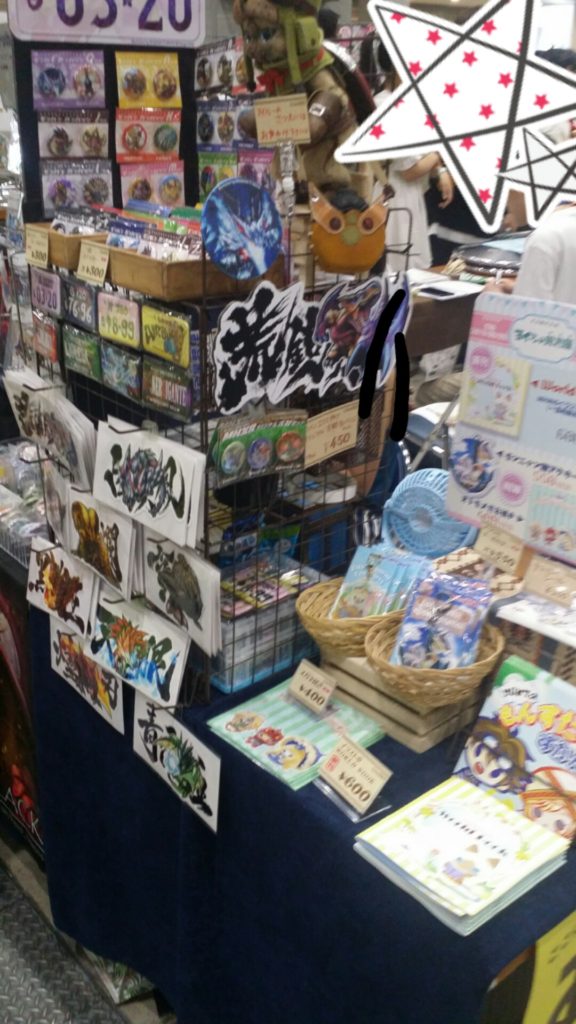
Do you have any particular favorite games at the moment?
For a while now, I’ve been completely engrossed with the Monster Hunter series. It doesn’t seem to be as big a hit overseas;right now I’m all in with the Light Bowgun weapon and seeing just how strong I can get.
I also create lots of doujin fanart, and exhibit it at Comiket. I still display the signboard from Comiket at home, where it is hanging in my room.
Any other comments?
Thank you so much for all the interview questions this time.
While it seems that I may have given you my entire biography, the truth is that there are still so, so many things I’d like to discuss. Any time another chance arises I’d love to talk about it.
It would be a great honor to be able to communicate the creative processes of my game work to all those people overseas. Furthermore my dream would be to have many many people to help contribute memorial fanart. This could be illustrations or figures or take various other forms. Whichever the case I definitely want to take this on. In our current era, even if we do not all have the ability to speak multiple languages, we live in the era of highly efficient language translation apps. Depending on how we use this power, we can broaden communication between people of different backgrounds and close the gaps between us.
For those looking for fanart, please recommend some via commission. It’s not just limited to old games. Please reach out for consultation.
See you next time!
Special thanks to West-Maison for his time and patience! If readers have any further questions they want answered, you can go directly to him on Twitter. Alternatively, you can send them over to me, as I would like to do a follow-up interview in the future. Thank you for reading!
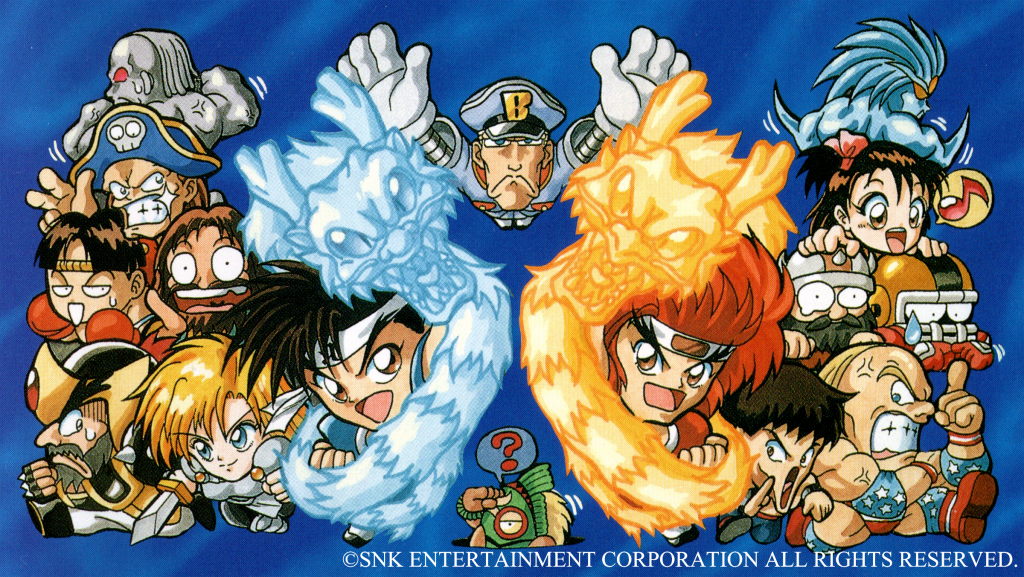
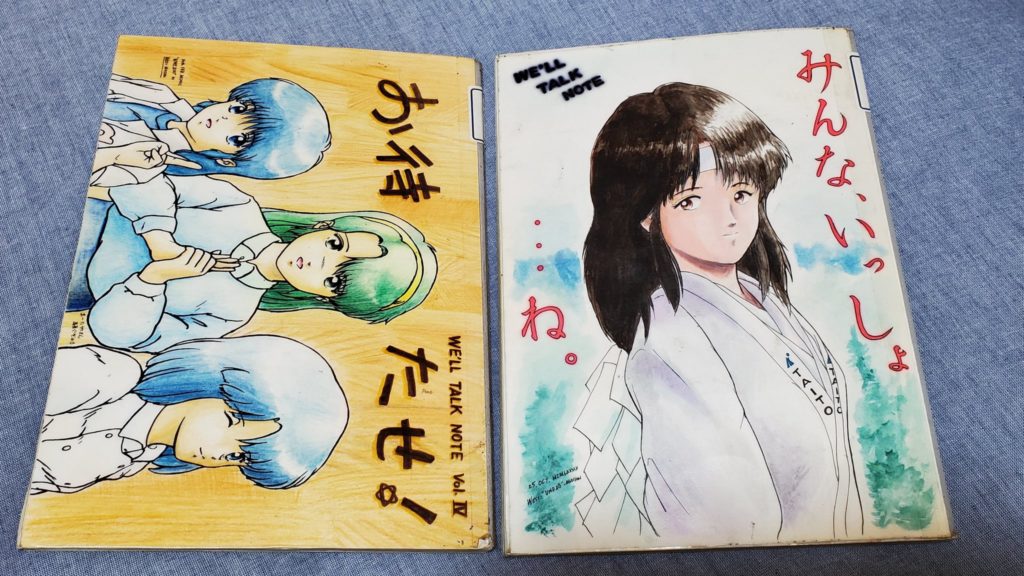
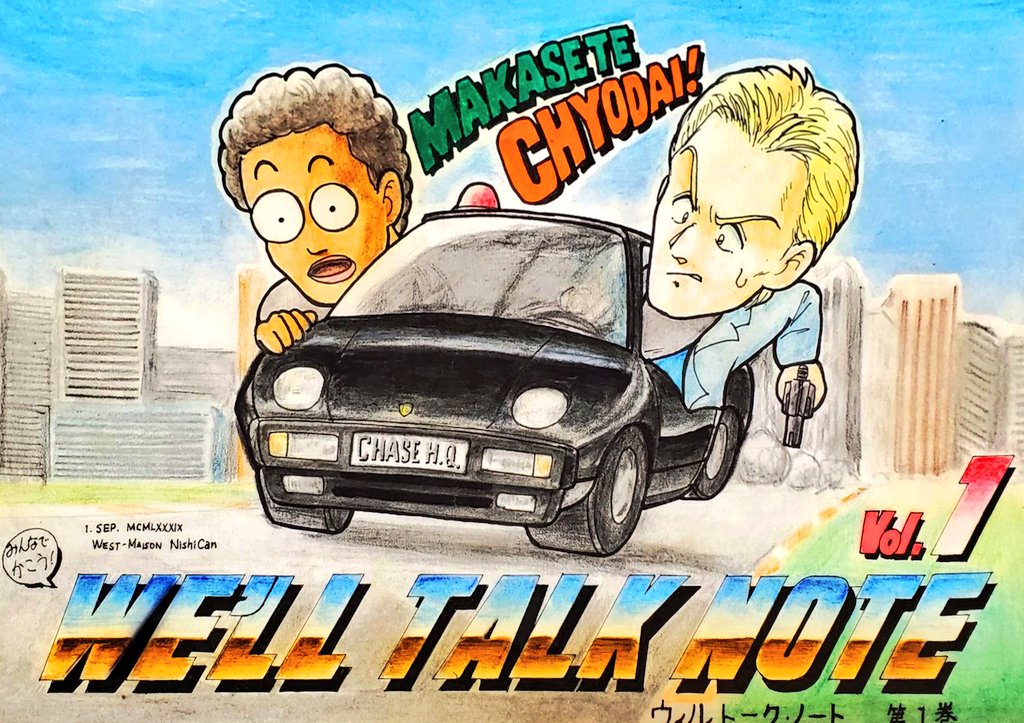
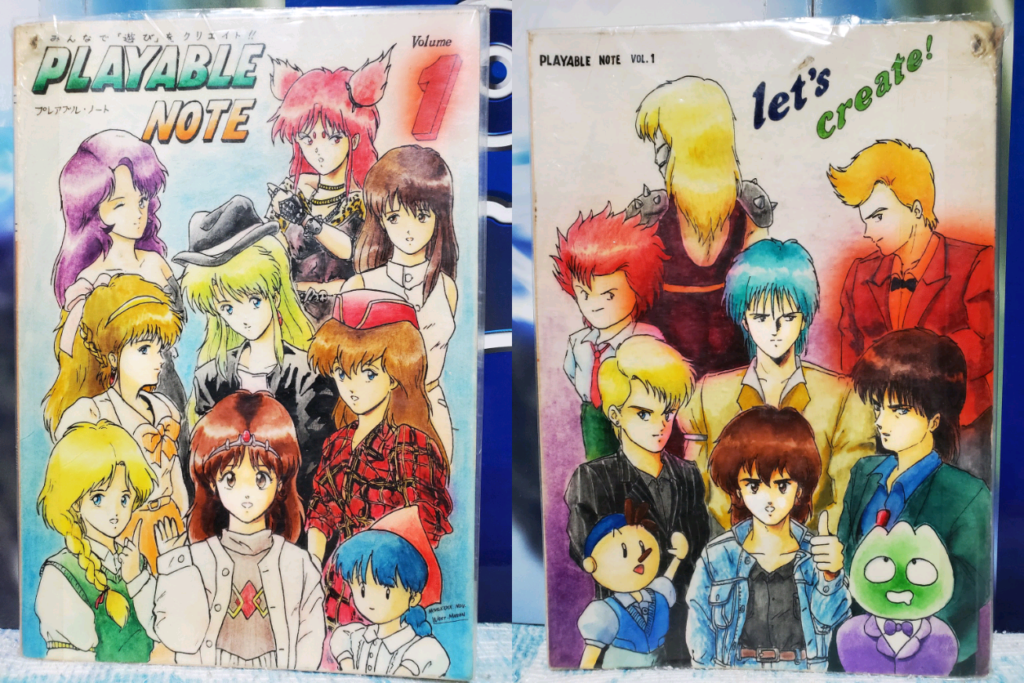
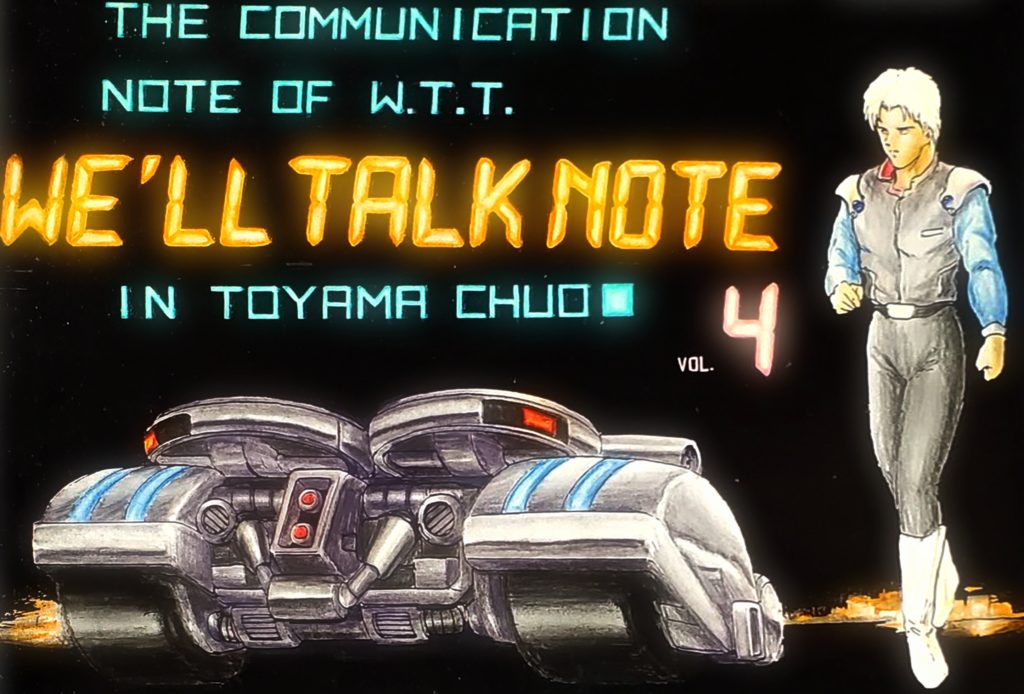
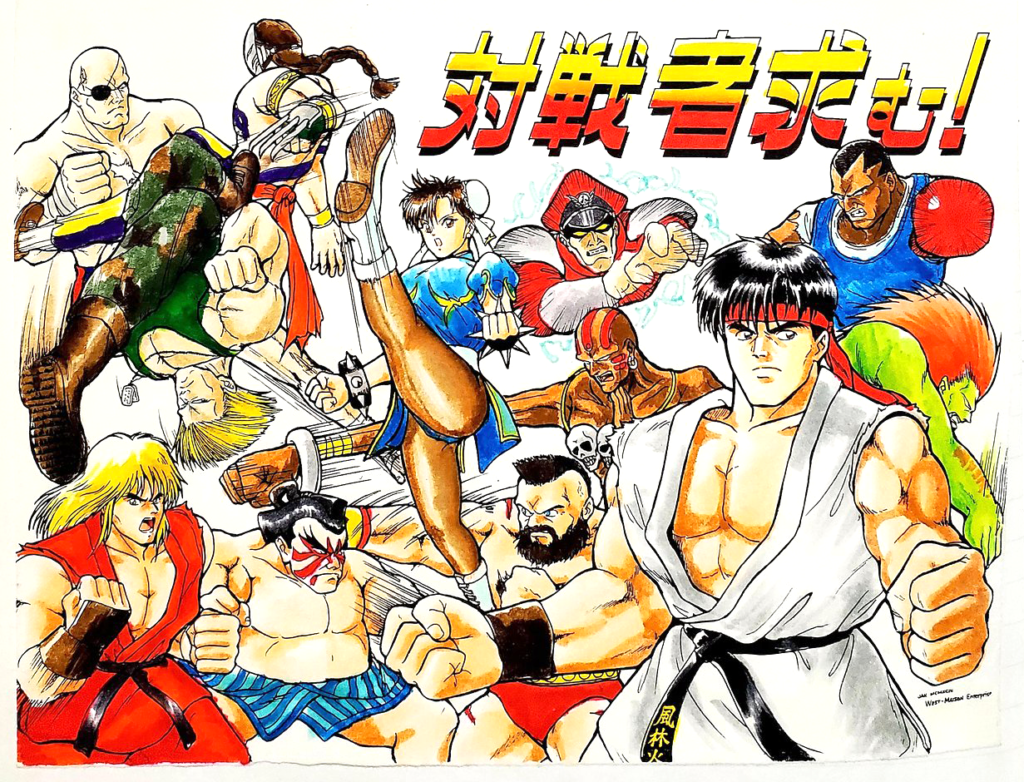
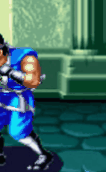
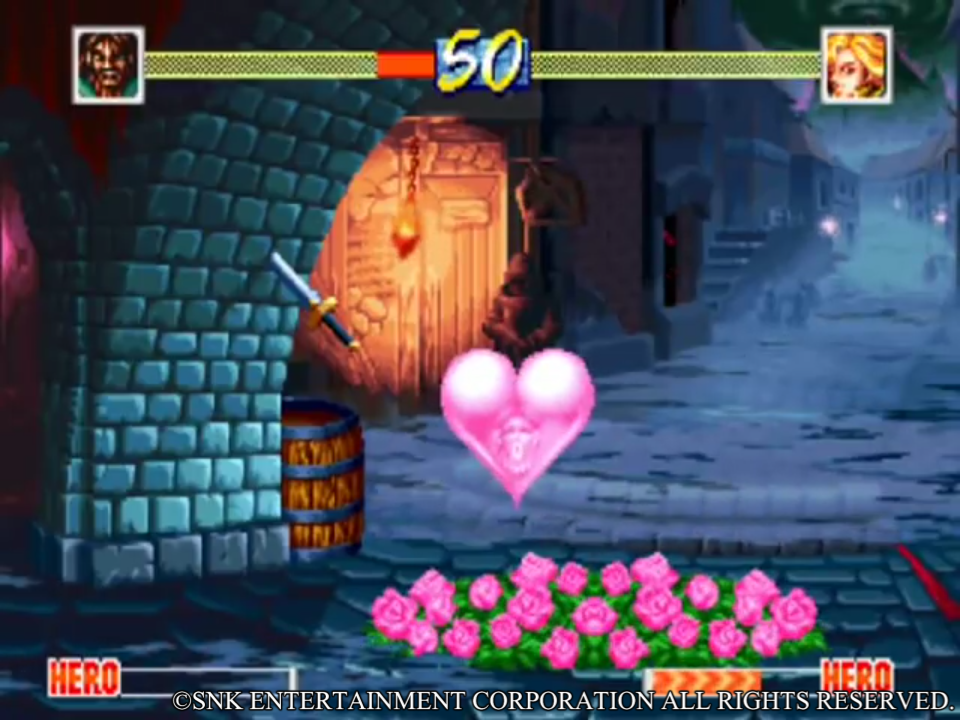
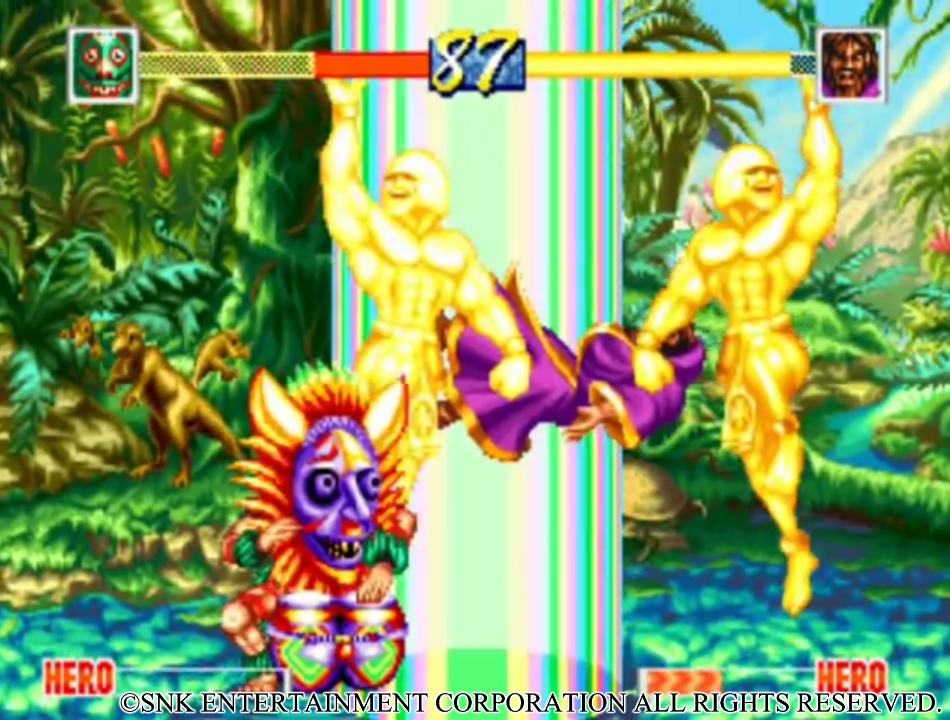

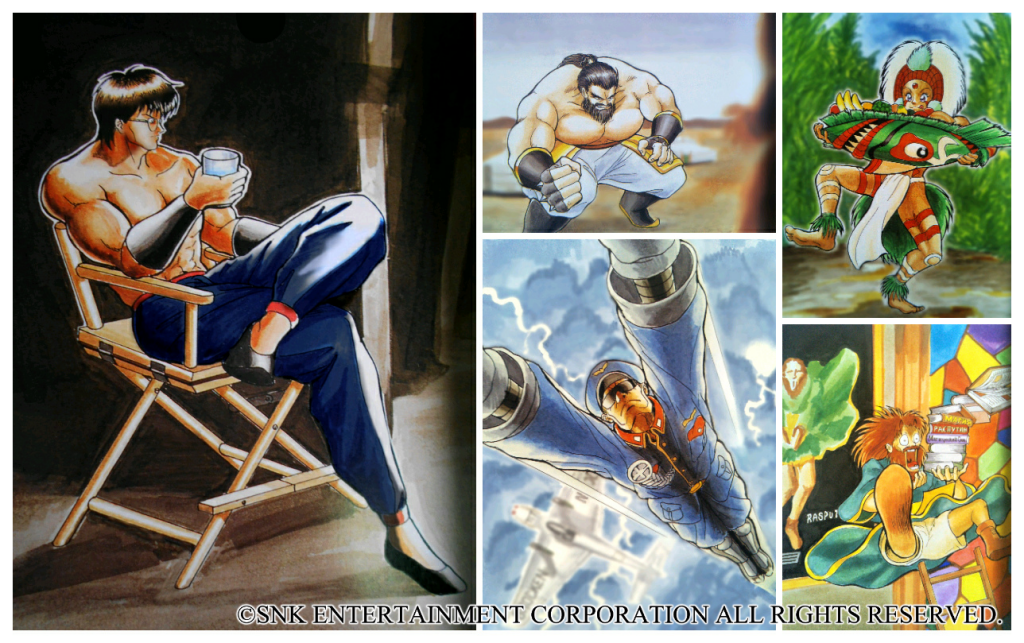
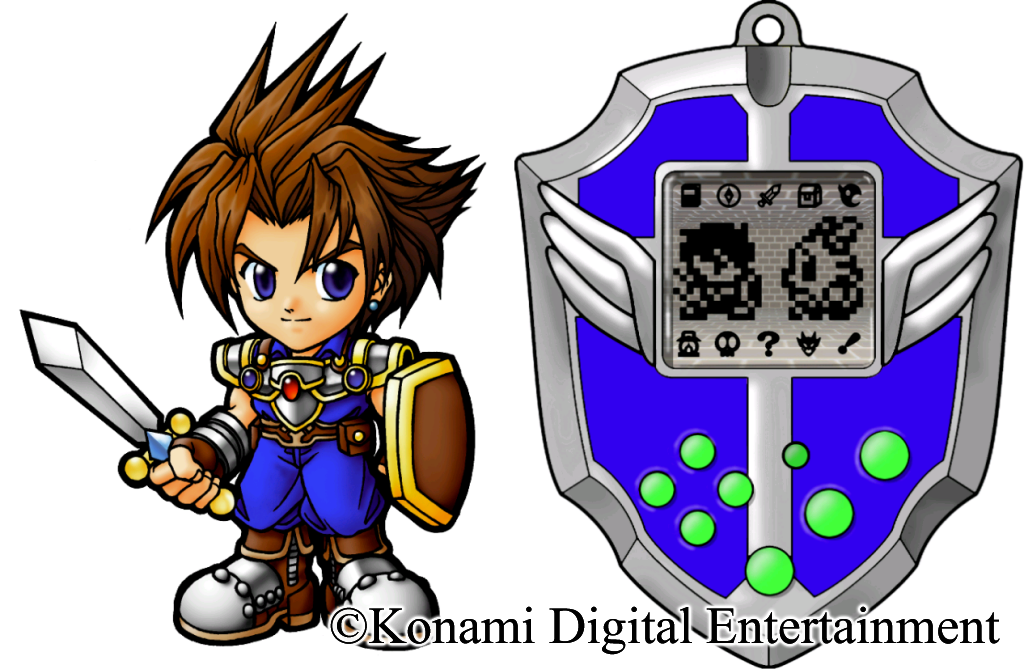
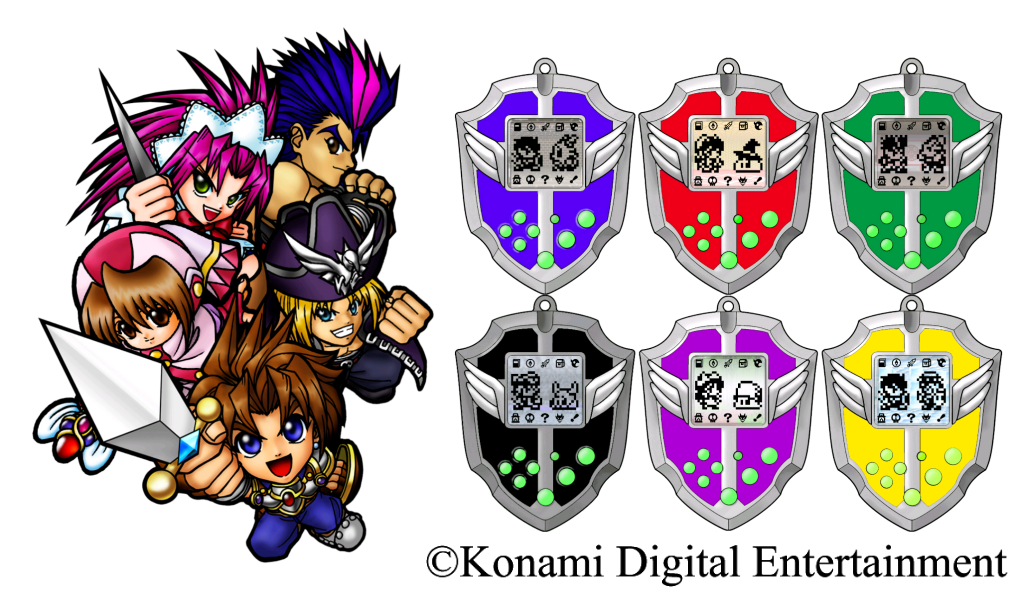
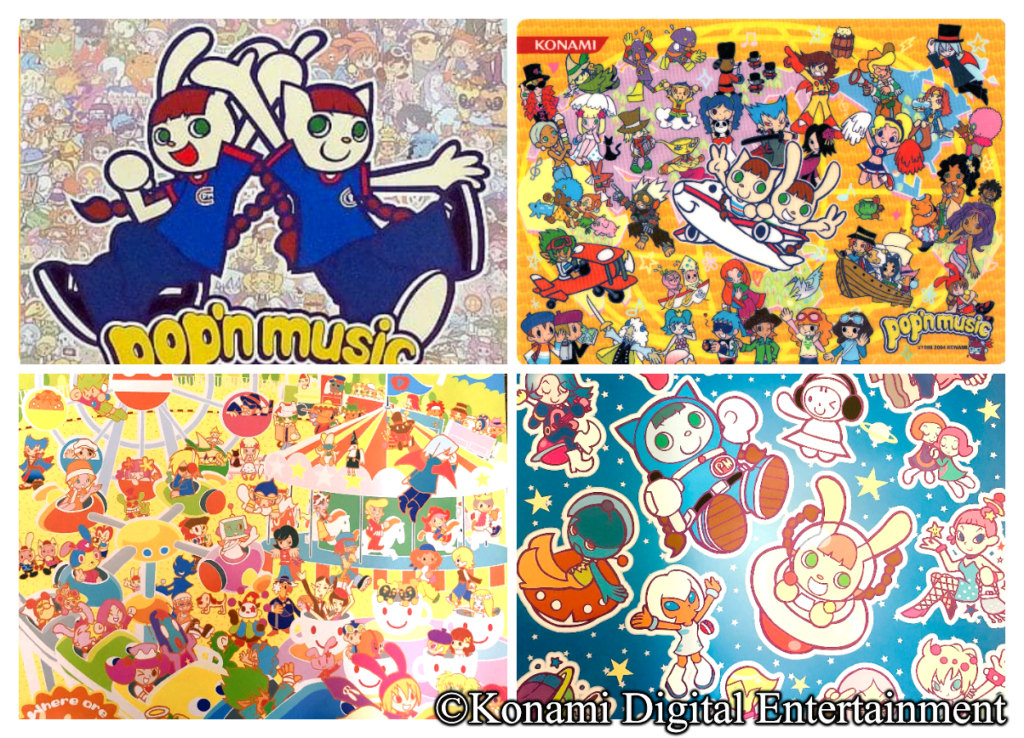
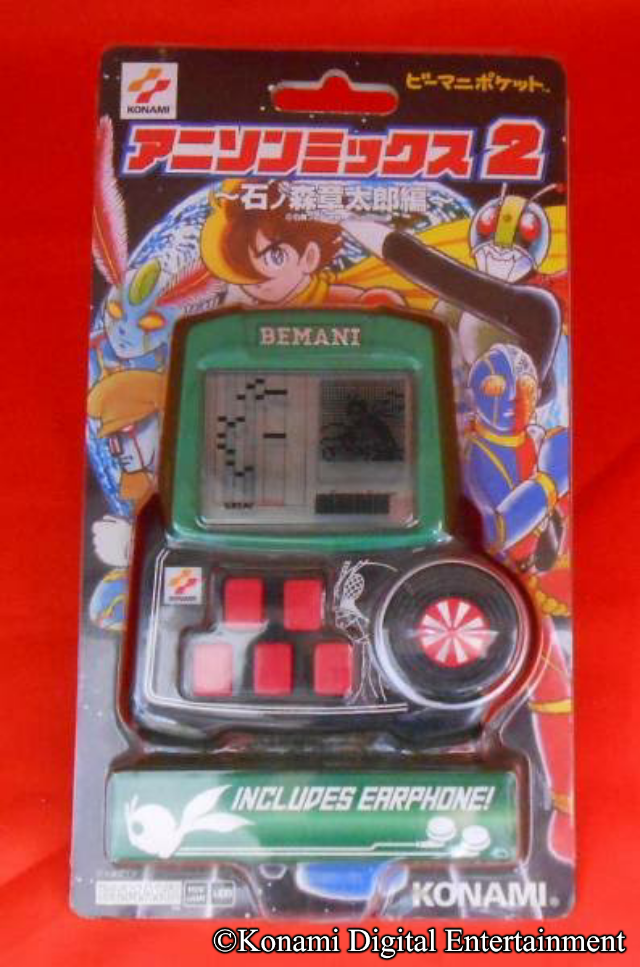
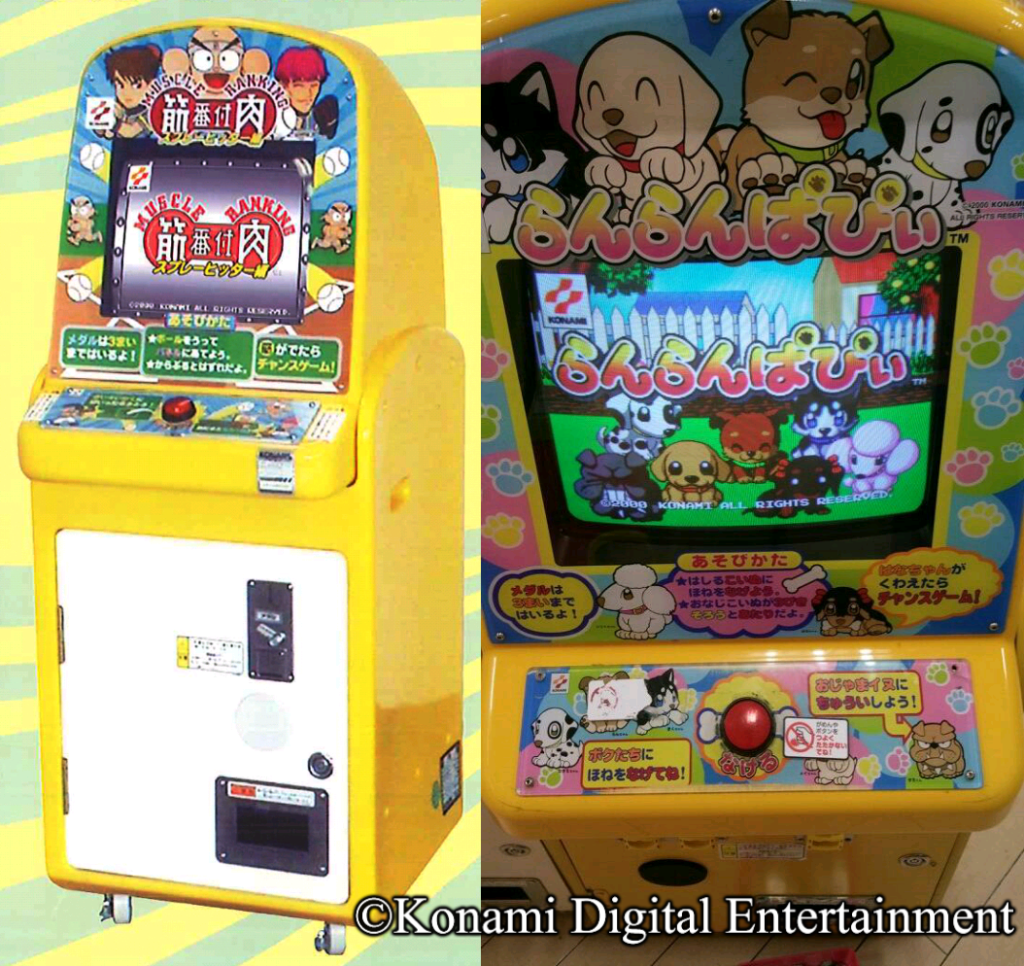
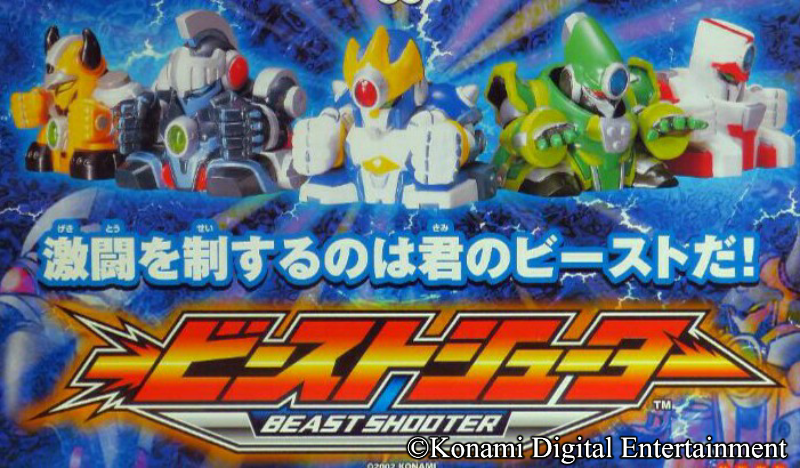


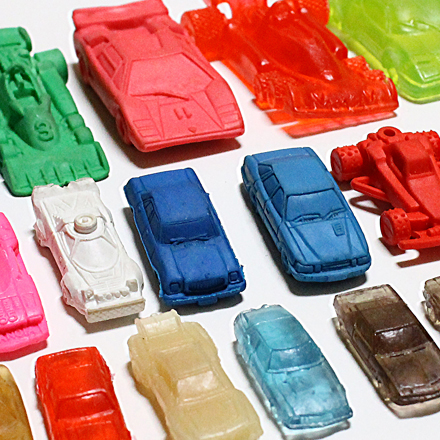

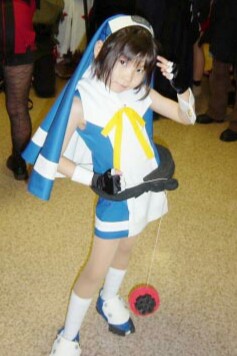
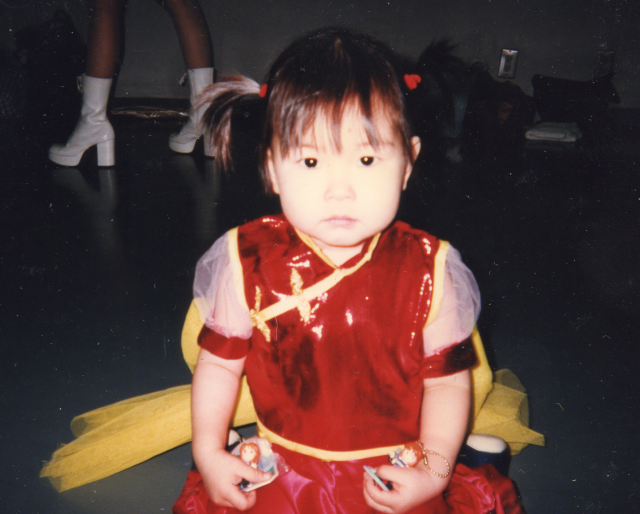
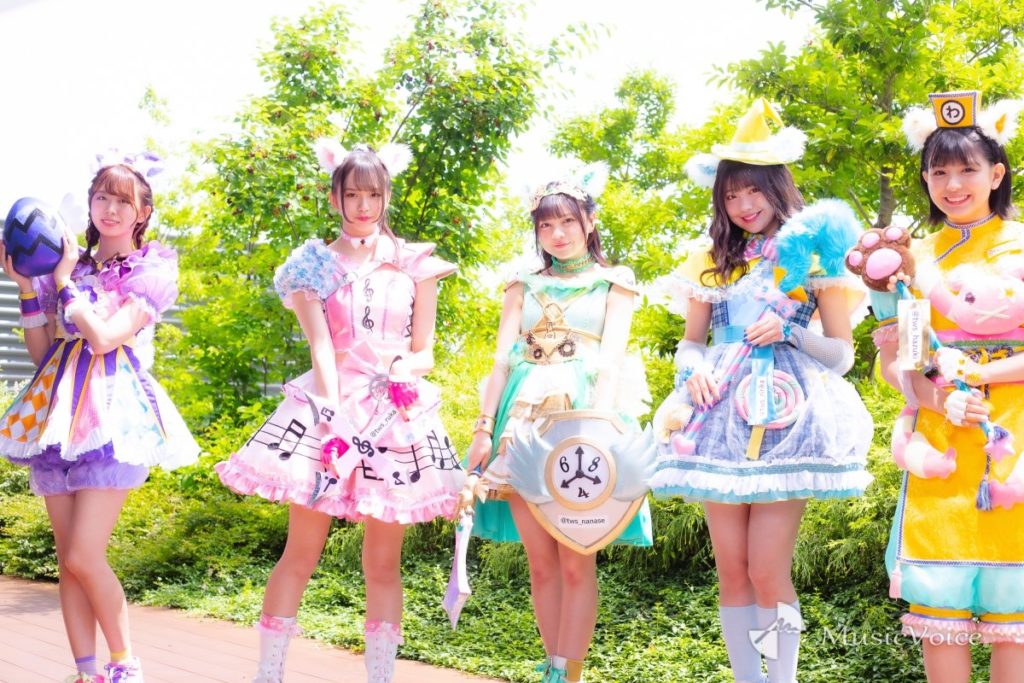
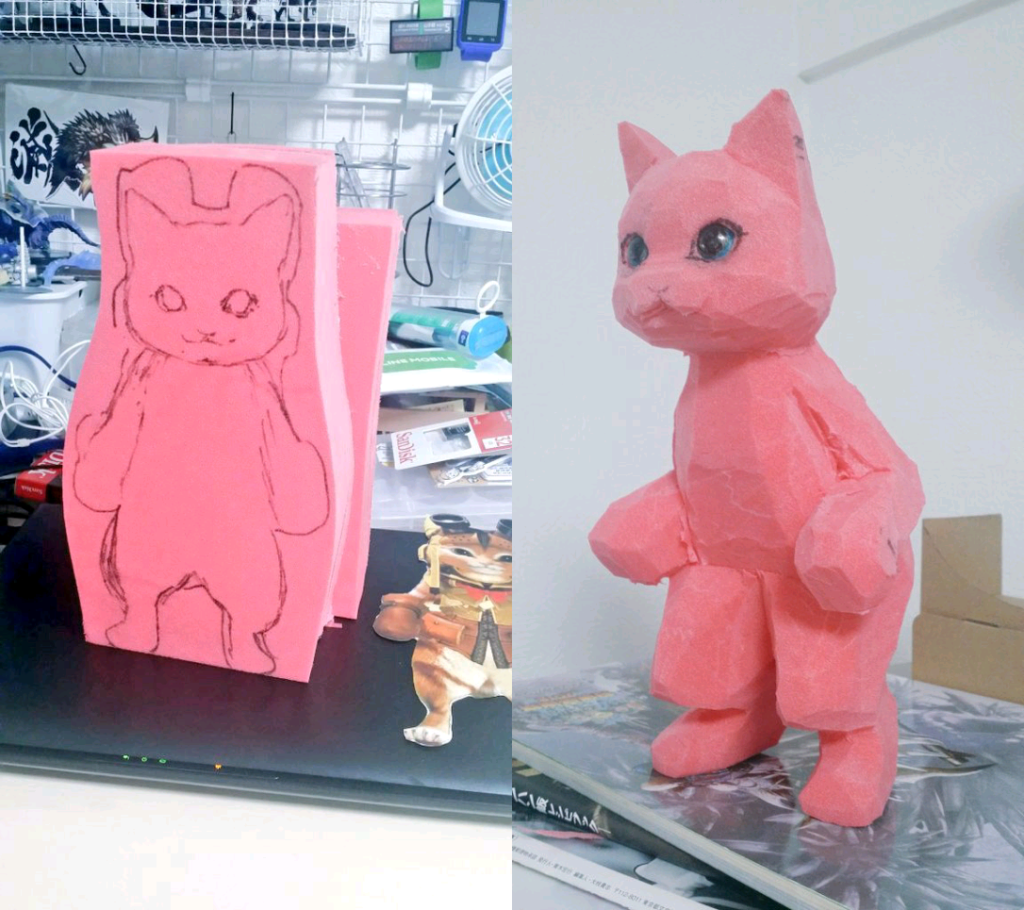

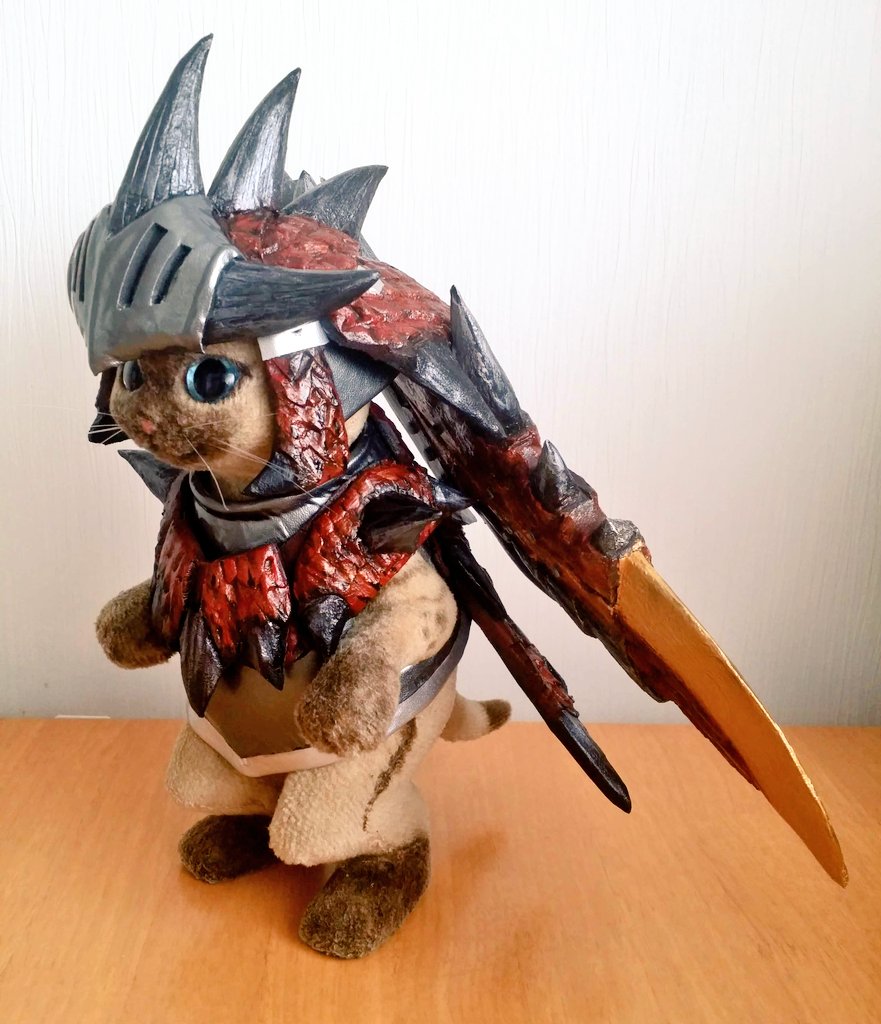
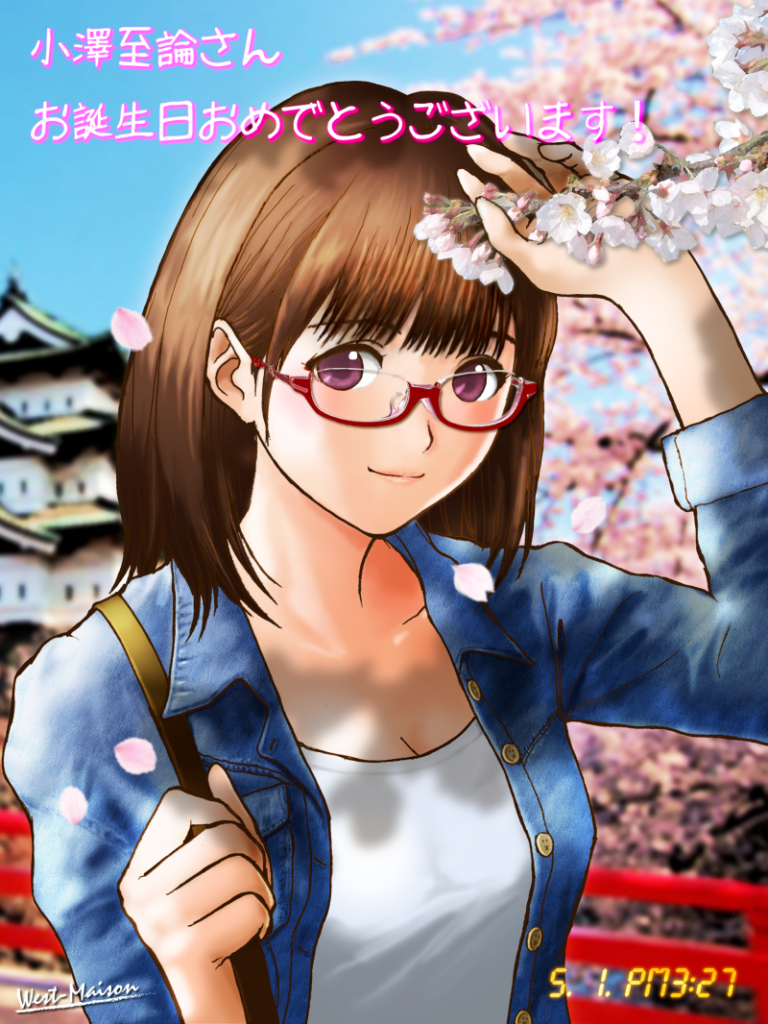


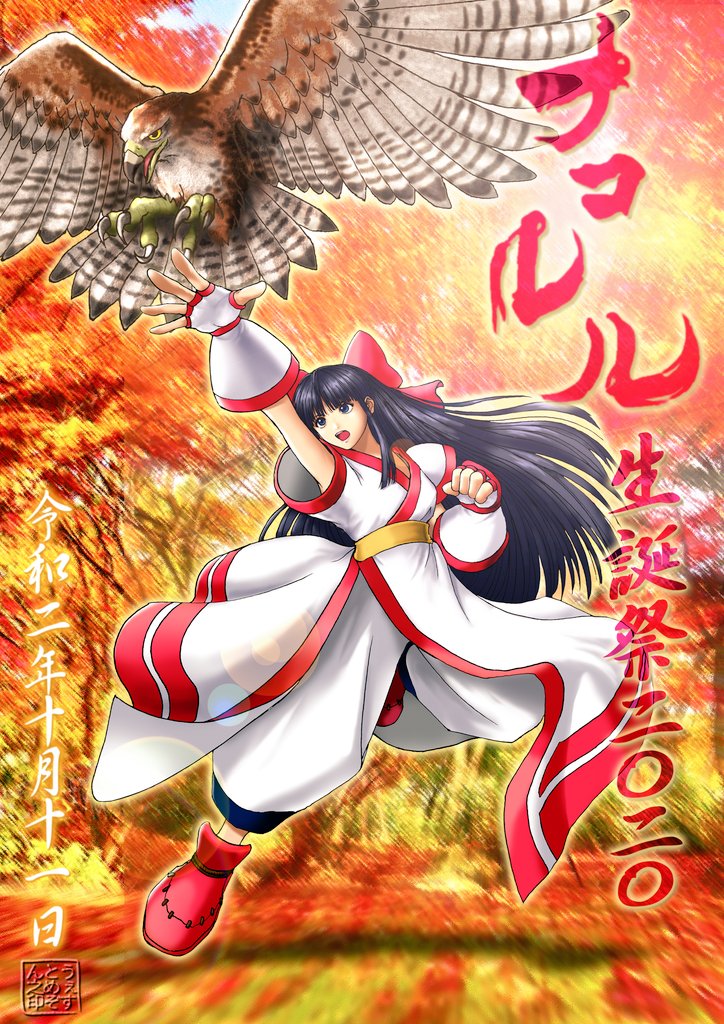
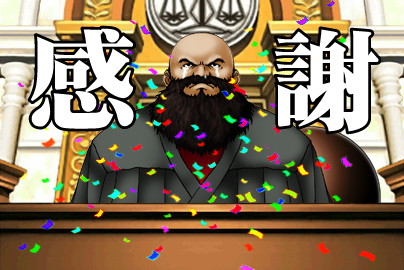
> I loved both the BGM and game worldview.
Btw this word 世界観 that gets translated as “worldview” actually means like “the aesthetic of the series”. It’s like reverse wasei-eigo.